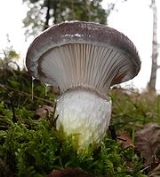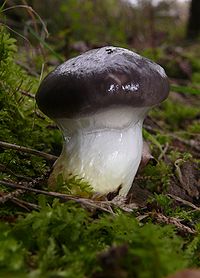
Gomphidius glutinosus
Encyclopedia
Gomphidius glutinosus, commonly known as the slimy spike-cap, is a gilled mushroom found in Europe
. Although it has gills, it is a member of the order Boletales
, along with the boletes. The fruiting bodies sprout in pine, fir and spruce woodland in Europe in autumn. Initially, are completely covered with a slimy veil, breaking through to reveal a greyish or brownish-capped mushroom with decurrent greyish gills which sometimes resembles a child's top
. Opinions differ on the suitability of this mushroom for the table, some guides hold it in high regard, while others view it with caution.
mycologist Jacob Christian Schäffer
as Agaricus glutinosus in 1774, before the father of mycology Elias Magnus Fries
gave it its current genus and binomial name in 1838. The genus name is derived from the Greek
'γομφος' gomphos meaning "plug" or "large wedge-shaped nail". The specific epithet glutinosus is the Latin
adjective "sticky".
Alternate common names in Germany are Kuhmaul "cow snout", and Rotzer.
 Said to resemble a child's top
Said to resemble a child's top
, the mushroom has a dark brownish or greyish cap
up to 12 cm (4.5 in) in diameter; it has a central boss and an inrolled margin, and is initially convex and later flattens and may develop blackish markings. As with other members of the genus, the whole mushroom is often covered with slimy or sticky veil when young. The fungus tears free of the veil as it grows, leaving some strands and an indistinct ring
. The stipe
is 3.5–10 cm (1.4–4 in) high and 1–2 cm wide, and is white with a greyish tint and often flushed yellow at the base. The whitish flesh may have a wine-coloured tinge and has little taste or smell. The widely-spaced decurrent gills are waxy in texture, with a hairy surface from the cystidia. Sometimes branched, they are initially whitish, then grey and later blackening with spores, and the spore print
is brownish-black. The large spores are spindle-shaped and measure 17–20 μm long by 5.5–6 μm wide.
Brownish specimens may be mistaken at a glance for Suillus luteus
, but a quick look under the cap will see there are gills rather than pores. Another similar species is Hygrophorus hypothejus
, found in similar habitat though with yellow gills which do not separate from the cap.
upon Suillus bovinus
.
Two specimens of Gomphidius glutinosus were found in Brechfa Forest
on the 25th Of July 2009. The only boletus to be found in the vicinity was Suillus grevillei
.
Europe
Europe is, by convention, one of the world's seven continents. Comprising the westernmost peninsula of Eurasia, Europe is generally 'divided' from Asia to its east by the watershed divides of the Ural and Caucasus Mountains, the Ural River, the Caspian and Black Seas, and the waterways connecting...
. Although it has gills, it is a member of the order Boletales
Boletales
The Boletales are an order of Agaricomycetes, containing over 1300 species with a diverse array of fruiting body types. The boletes are the best known members of this group, and until recently, the Boletales were thought to only contain boletes...
, along with the boletes. The fruiting bodies sprout in pine, fir and spruce woodland in Europe in autumn. Initially, are completely covered with a slimy veil, breaking through to reveal a greyish or brownish-capped mushroom with decurrent greyish gills which sometimes resembles a child's top
Top
A top is a toy that can be spun on an axis, balancing on a point. This motion is produced in the most simple forms of top by twirling the stem using the fingers. More sophisticated tops are spun by by holding the axis firmly while pulling a string or twisting a stick or pushing an auger as shown...
. Opinions differ on the suitability of this mushroom for the table, some guides hold it in high regard, while others view it with caution.
Taxonomy
Gomphidius glutinosus was initially described by GermanGermany
Germany , officially the Federal Republic of Germany , is a federal parliamentary republic in Europe. The country consists of 16 states while the capital and largest city is Berlin. Germany covers an area of 357,021 km2 and has a largely temperate seasonal climate...
mycologist Jacob Christian Schäffer
Jacob Christian Schäffer
Jakob or Jacob Christian Gottlieb Schäffer or Schäffern was a German dean, professor, botanist, mycologist, entomologist, ornithologist and inventor.-Biography:...
as Agaricus glutinosus in 1774, before the father of mycology Elias Magnus Fries
Elias Magnus Fries
-External links:*, Authors of fungal names, Mushroom, the Journal of Wild Mushrooming.*...
gave it its current genus and binomial name in 1838. The genus name is derived from the Greek
Ancient Greek
Ancient Greek is the stage of the Greek language in the periods spanning the times c. 9th–6th centuries BC, , c. 5th–4th centuries BC , and the c. 3rd century BC – 6th century AD of ancient Greece and the ancient world; being predated in the 2nd millennium BC by Mycenaean Greek...
'γομφος' gomphos meaning "plug" or "large wedge-shaped nail". The specific epithet glutinosus is the Latin
Latin
Latin is an Italic language originally spoken in Latium and Ancient Rome. It, along with most European languages, is a descendant of the ancient Proto-Indo-European language. Although it is considered a dead language, a number of scholars and members of the Christian clergy speak it fluently, and...
adjective "sticky".
Alternate common names in Germany are Kuhmaul "cow snout", and Rotzer.
Description

Top
A top is a toy that can be spun on an axis, balancing on a point. This motion is produced in the most simple forms of top by twirling the stem using the fingers. More sophisticated tops are spun by by holding the axis firmly while pulling a string or twisting a stick or pushing an auger as shown...
, the mushroom has a dark brownish or greyish cap
Pileus (mycology)
The pileus is the technical name for the cap, or cap-like part, of a basidiocarp or ascocarp that supports a spore-bearing surface, the hymenium. The hymenium may consist of lamellae, tubes, or teeth, on the underside of the pileus...
up to 12 cm (4.5 in) in diameter; it has a central boss and an inrolled margin, and is initially convex and later flattens and may develop blackish markings. As with other members of the genus, the whole mushroom is often covered with slimy or sticky veil when young. The fungus tears free of the veil as it grows, leaving some strands and an indistinct ring
Annulus (mycology)
An annulus is the ring like structure sometimes found on the stipe of some species of mushrooms. The annulus represents the remaining part of the partial veil, after it has ruptured to expose the gills or other spore-producing surface. An annulus may be thick and membranous, or it may be cobweb-like...
. The stipe
Stipe (mycology)
thumb|150px|right|Diagram of a [[basidiomycete]] stipe with an [[annulus |annulus]] and [[volva |volva]]In mycology a stipe refers to the stem or stalk-like feature supporting the cap of a mushroom. Like all tissues of the mushroom other than the hymenium, the stipe is composed of sterile hyphal...
is 3.5–10 cm (1.4–4 in) high and 1–2 cm wide, and is white with a greyish tint and often flushed yellow at the base. The whitish flesh may have a wine-coloured tinge and has little taste or smell. The widely-spaced decurrent gills are waxy in texture, with a hairy surface from the cystidia. Sometimes branched, they are initially whitish, then grey and later blackening with spores, and the spore print
Spore print
thumb|300px|right|Making a spore print of the mushroom Volvariella volvacea shown in composite: mushroom cap laid on white and dark paper; cap removed after 24 hours showing pinkish-tan spore print...
is brownish-black. The large spores are spindle-shaped and measure 17–20 μm long by 5.5–6 μm wide.
Brownish specimens may be mistaken at a glance for Suillus luteus
Suillus luteus
Suillus luteus is a basidiomycete fungus, and the type species of the genus Suillus. It is a common fungus indigenous to coniferous forests of Eurasia and North America, and introduced to southern Australia and New Zealand...
, but a quick look under the cap will see there are gills rather than pores. Another similar species is Hygrophorus hypothejus
Hygrophorus hypothejus
Hygrophorus hypothejus is an edible species of fungus in the genus Hygrophorus....
, found in similar habitat though with yellow gills which do not separate from the cap.
Distribution and habitat
Gomphidius glutinosus is found in Europe, where it occurs in autumn under pine and fir trees, both in natural woods and plantations, generally singularly or scattered. Fruiting bodies sprout in the autumn.Ecology
Like other members of the family Gomphidiaceae, Gomphidius glutinosus has been thought to be ectomycorrhizal, forming symbiotic relationship with their host trees. However, there is now evidence that many (and perhaps all) species in this group are parasitic upon ectomycorrhizal boletes, in relationships that are often highly species-specific, such as Gomphidius roseusGomphidius roseus
Gomphidius roseus, commonly known as the rosy spike-cap or pink gomphidius, is a gilled mushroom found in Europe. Although it has gills, it is a member of the order Boletales, along with the boletes...
upon Suillus bovinus
Suillus bovinus
Suillus bovinus, also known as the Jersey cow mushroom, is a pored mushroom of the genus Suillus in the Suillaceae family. It is an edible mushroom that often grows in a symbiosis with pine.-Description:...
.
Two specimens of Gomphidius glutinosus were found in Brechfa Forest
Brechfa Forest
The Brechfa Forest is an area of forest in Carmarthenshire, south Wales.Much of the planting took place during the 1930s, with work carried out by young unemployed men from a Ministry of Labour work camp...
on the 25th Of July 2009. The only boletus to be found in the vicinity was Suillus grevillei
Suillus grevillei
Suillus grevillei is a mycorrhizal mushroom with a tight, brilliant and dry cap where the hymenium easily separates from the flesh of the cap, with a central stalk that is quite slender...
.

